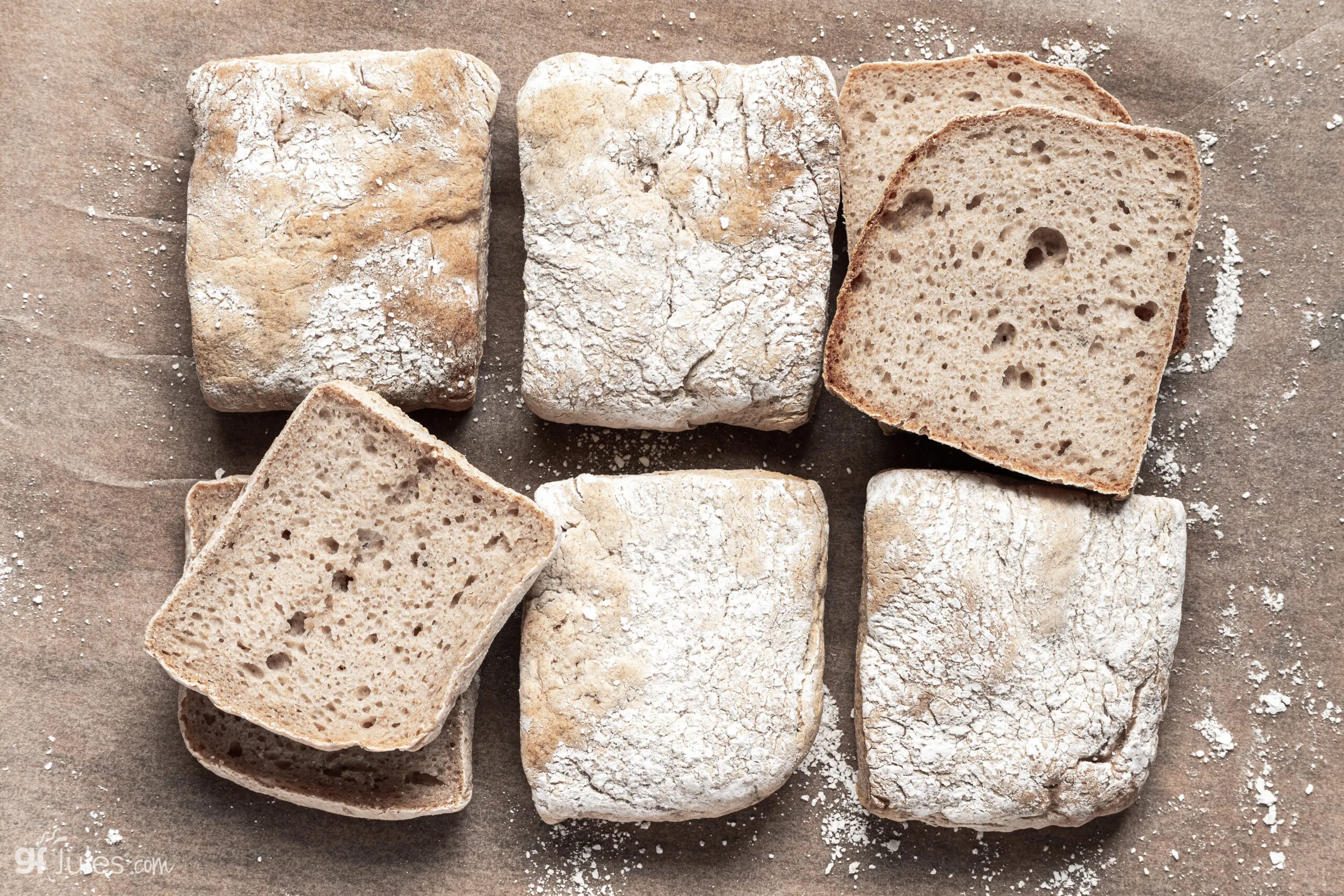
Gluten Free Ciabatta Rolls Recipe
Just like the classic Italian ciabatta rolls we all know and love, these vegan and gluten free ciabatta rolls will become a new favorite! *You need a baking stone for this recipe for best results.
Print
Pin
Servings: 4 large rolls
Ingredients
- 1 gfJules Gluten Free Bread Mix
- 1 Tbs. (15 g) granulated sugar
- 1 packet (2 ¼ tsp. / 7 g.) quick rise yeast
- 2 Tbs. extra virgin olive oil
- 2 tsp. apple cider vinegar
- 1 ¾ cups warm water
Instructions
Making the ciabatta bread dough:
- 1. Using a stand mixer with the flat paddle attachment or a large bowl with wooden spoon, add gfJules Gluten Free Bread Mix, sugar, plus yeast packet and whisk together briefly. (If making a gluten free bread mix from scratch, gather the dry ingredients from this recipe instead and add those. The results will not be the same, but they it will work. You may also wish to add 1 Tbs. Psyllium Husk Fiber to the dry ingredients if you find that your homemade dough doesn't have the texture of the breads photographed here).
- 2. Add oil, vinegar, and water, mixing slowly until the dough comes together and is smooth and pulling away from the sides of the mixing bowl. The dough will be sticky but not wet.
Forming the ciabatta rolls:
- Note that you'll need a pizza stone or baking stone or baking steel for this recipe for best results. Otherwise, use a heavy duty baking sheet.
- Turn out the dough onto a well-floured surface (use gfJules Flour or a gluten free starch – do not use a gritty gluten free flour) and shape it into a flattened ball.
- 2. Roll out the dough into a rough rectangle about ½ inch thick. The size of the rectangle isn't important, it's most important not to rolled the dough too thin.
- 3. Use a bench scraper or a sharp knife to cut down the middle of the rectangle and again twice across horizontally to divide the dough into six rectangle-ish shapes. You can cut all the edges so they are even rectangles or leave some of the sides rough and rustic – it’s your choice.
- 4. Prepare a baking sheet the same size as your baking stone by lining with parchment paper. Flip each ciabatta roll over so the floured side is facing up and lay each on the parchment with at least 2 inches between each roll.
- 5. Spray a sheet of plastic wrap with oil and lay over top of the rolls. Set the rolls aside to proof until doubled in size. A good spot for this is in an oven that’s been warmed to 200ºF then turned off, or an oven with the light on.
Baking Ciabatta Rolls:
- 1. While the rolls are rising, place a pizza stone, baking steel, or a thick, heavy-duty baking sheet turned upside-down on the lower middle oven rack. Preheat the oven to 475ºF. The stone will need this full time to preheat.
- 2. After about an hour, or once your rolls have doubled in size, slide them (along with the parchment/baking paper) onto the hot stone or baking steel/sheet and reduce the oven temperature to 425ºF. {The parchment will have become moist from the rolls rising and may be
difficult to “slide” off of the baking sheet onto the stone, so you’ll need to do this carefully so as not to tear the parchment or burn yourself! I found that transferring the parchment to a pizza peel and then to the baking stone was helpful, but you may find an alternate method that suits you better.}* - 3. Bake at 425ºF for 20-30 minutes, or until the rolls are browning, have reached an internal temperature of 205 ºF or higher and/or a toothpick inserted into the centers comes out clean and dry.
- 4. Remove the ciabatta rolls from the oven and cool them on a wire rack.
- 5. Allow the ciabatta rolls to cool completely before slicing so that they will not be gummy inside. Slice lengthwise for sandwiches or open-faced serving or slice like loaves for dips and appetizers.
Notes
*If you like your ciabatta rolls even crustier, place a cast iron skillet or heavy duty metal baking tray (not glass!) on the bottom of the oven or on the bottom rack with 6 ice cubes in the pan when you first place your rolls in the oven.
** Please keep in mind that nutrition information provided is per serving, which may vary. While we have taken care to provide you with the most accurate nutritional values possible, please note that this information may differ significantly depending on the exact ingredients and brands that you choose to use to make this recipe. Additionally, where options are given for ingredients, the resulting calculation may include all ingredient options instead of only one per line, skewing the totals significantly.